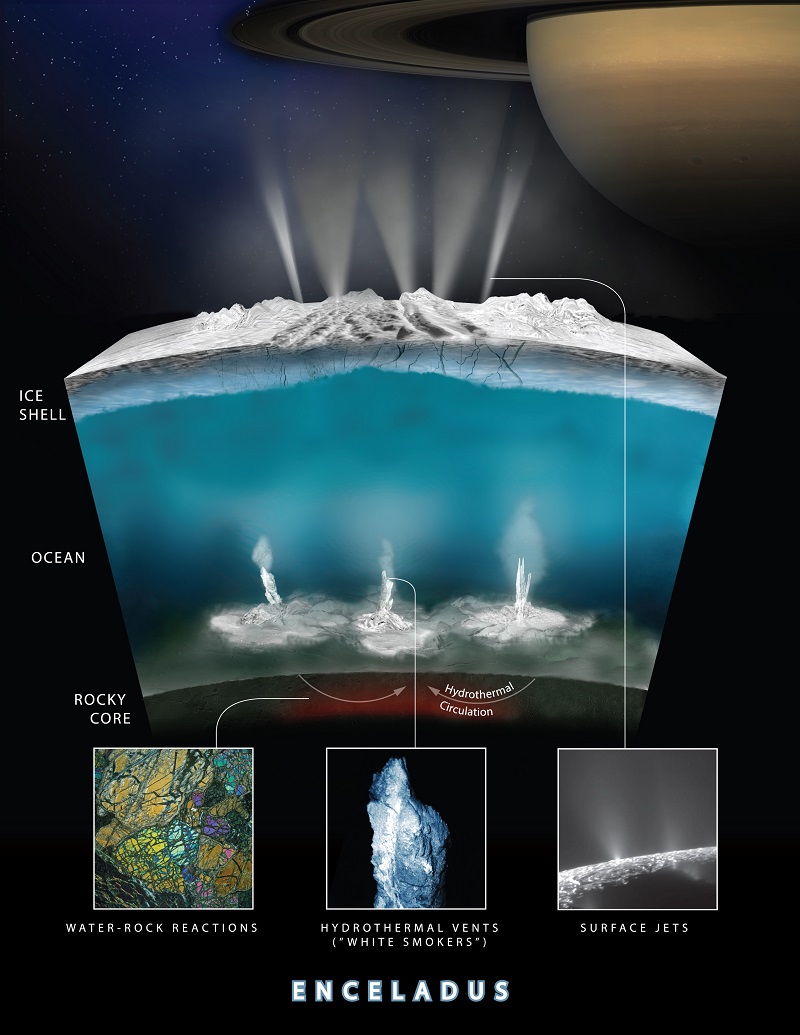December 13, 2019
by Andreea Sterea
It took scientists almost 15 years, but they finally made it. They understood and explained the tiger stripes on Saturn’s moon Enceladus. All they have to do now is find alien life under its icy crust.
What Is Enceladus and Why Is Everyone Obsessed with Its Tiger Stripes?
First things first, Enceladus is Saturn’s sixth largest moon (about 313 miles wide). Discovered in the late 18th century, the satellite kept astronomers and scientists on their toes because of its unique features. It is a moon with hydro-thermal activity, which is rare in and out of itself. Enceladus features a global ocean underneath its ice crust.
However, the mystery that has been baffling scientists in the last 15 years was the tiger stripes. These stripes are crust fissures through which the ocean water underneath erupts to the surface in icy sprays. To science’s knowledge, Enceladus is the only icy rock that spreads water in space so our probes can sample it.
However, there is more to the Enceladus and its tiger stripes than meets the eye. Besides the fact that water bursts through the fissures, these crust fractures themselves are strange. They are parallel and evenly spaced, about 80 miles long and 21 miles apart and they occur on the south pole of the satellite. Why and how such stripes came to existence is the enigma that scientists have been trying to solve ever since NASA’s Cassini mission to Saturn discovered them back in 2005.

Understanding the Tiger Stripes on Enceladus
The most prominent Enceladus tiger stripes bear the names of Baghdad, Cairo, Alexandria, and Damascus – inspired from places in 1,001 Arabian Nights. Given the fact that the underneath icy salt water ocean erupts through them into the vastness of cosmos, scientists wanted to understand their origin and their bizarre parallel and evenly-spaced placement on the moon’s surface.
In a study published in Nature Astronomy, researchers at Carnegie Science finally explain the phenomenon.
According to the scientists, the tiger stripes on Enceladus’s south pole owe their existence to chance. In fact, the fissures could have formed on either pole. It just happened that the south one was the first to split open.
Moreover, scientists believe that Baghdad was the first stripe to form. As the icy water underneath the crust erupted from the Baghdad crevice, it led to the formation of other fractures on either side. More and more tiger stripes formed as water continued erupting from the new crust fissures.
If one wants to find a responsible party for the phenomenon, it’s Saturn. Its colossal gravity deformed the moon’s shape. In turn, the moon’s orbit is also responsible for the tiger stripes forming at the poles.
Doug Hemingway, lead author and researcher at Carnegie Science said in a statement that
“Since it is thanks to these fissures that we have been able to sample and study Enceladus’ subsurface ocean, which is beloved by astrobiologists, we thought it was important to understand the forces that formed and sustained them. Our modeling of the physical effects experienced by the moon’s icy shell points to a potentially unique sequence of events and processes that could allow for these distinctive stripes to exist.”
Everybody Loves The Tiger Stripes on Enceladus
Against all odds, Enceladus is not a dead block of ice in space. On the contrary, it is a veritable fountain of wonders for the scientists looking for alien life. Earlier this year, NASA Goddard Space Flight Center researcher Marc Neveu wrote that the ocean under Enceladus’s crust is about 1 billion years old, the perfect age for life to have emerged and still have some power to it.
In the past years, Enceladus sparked the science community’s interest as researchers discovered complex organic molecules in the ocean and the presence of hydrogen in its atmosphere. As you can easily figure out, Enceladus is a prime candidate to search for alien life. Of course, there is also Titan, Saturn’s most prominent moon, another objective in NASA’s quest to find E.T.
Want more science now?
Check out our news page where we post interesting studies and discussions (sometimes mocking them mercilessly) for more.
